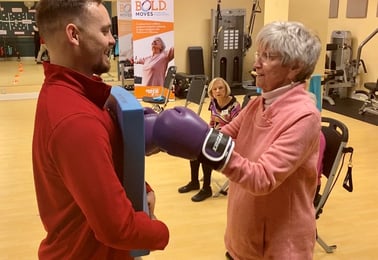 What is Parkinson’s? It is neurodegenerative disorder that affects movement. An individual might start with a gradual tremor in one hand, but this disease can result in numerous symptoms at different levels of severity including stiffness, slowing of movement, and disturbances to his/ her sense of balance. It cannot be cured but medications are given to try to improve symptoms. Exercises can be prescribed to help improve strength, flexibility, and balance and adherence to a regular exercise program is one of the best treatments options in managing symptoms and empowering those with Parkinson’s to fight back against the disease!
What is Parkinson’s? It is neurodegenerative disorder that affects movement. An individual might start with a gradual tremor in one hand, but this disease can result in numerous symptoms at different levels of severity including stiffness, slowing of movement, and disturbances to his/ her sense of balance. It cannot be cured but medications are given to try to improve symptoms. Exercises can be prescribed to help improve strength, flexibility, and balance and adherence to a regular exercise program is one of the best treatments options in managing symptoms and empowering those with Parkinson’s to fight back against the disease!
There are multiple benefits of exercise for those with Parkinson’s including:
- increasing muscle strength, flexibility, and balance
- improving well-being by reducing depression and anxiety
- slowing down the disease and controlling symptoms
- reducing pain and helping with emotional well-being
- preventing falls by building strength and decreasing fatigue
- improving sleep
The specificity of an exercise program for those with Parkinson’s is important to adequately manage symptoms and prevent fatigue.
- Most people should try to reach a goal of 30-40 min per week of cardiovascular exercise such as walking, biking, and swimming.
- As Parkinson’s can affect your posture, it is important to also add strength training and a stretch program to improve your core strength and overall range of motion.
There are different stages of the disease and medications will affect an individual suffering from Parkinson’s differently. Consulting with a qualified exercise physiologist who understands the unique needs of someone with Parkinson’s is important to ensure a safe and effective plan is being followed and tailored as needs change. An individual needs to be mindful of their movements, and at times, it can be overwhelming. A supportive exercise physiologist to observe, adjust and encourage participation can be a significant help! An individual with Parkinson’s needs to focus on walking heal to toe, taking large steps, swinging their arms, building core strength and upper back strength, and continue a quality stretch program. It is also best to continue sequential movements for brain health such as line dancing (crossing your feet and moving backwards might be a challenge) or boxing can also aid in brain health. Most importantly, find something you enjoy doing that contains all of these benefits, and make it apart of your lifestyle, ask your friends to join you!

